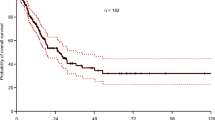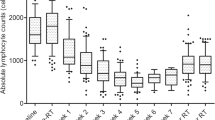Abstract
The purpose of this study was to investigate whether the minimum absolute lymphocyte count during radiotherapy (min ALC) and the absolute lymphocyte count 1 month after radiotherapy (post ALC) could predict clinical outcome in limited-stage small cell lung cancer (LS-SCLC) patients. We analyzed 73 LS-SCLC patients treated with chemotherapy and radiotherapy; we collected data on the min ALC from 62 patients and on the post ALC from 60 patients. Both min ALC and post ALC were statistically significant predictors of overall survival in multivariate analysis (hazard ratio [95 % confidence interval] 2.67 [1.06–6.75], P = 0.038 and 2.62 [1.19–5.74], P = 0.016, respectively). The median overall survival of the patients with min ALC ≤297 and >297 cells/μL was 12.2 and 35.3 months, respectively (P < 0.001). Patients with post ALC ≤698 and >698 cells/μL had an overall survival of 19.3 and 46.9 months, respectively (P = 0.001). The median overall survival of the lymphopenia (min ALC ≤ 297 cells/μL or post ALC ≤ 698 cells/μL) and the non-lymphopenia group (min ALC > 297 cells/μL and post ALC > 698 cells/μL) was 19.0 and 131.7 months, respectively, while the median progression survival was 8.1 and 16.6 months, respectively (P < 0.001 and P = 0.001). Radiation-related lymphopenia could predict poor survival in LS-SCLC. Its prognostic role should be evaluated in further prospective studies.


Similar content being viewed by others
Abbreviations
- Min ALC:
-
Minimum absolute lymphocyte count during radiotherapy
- Post ALC:
-
The absolute lymphocyte count 1 month after radiotherapy
- RRL:
-
Radiation-related lymphopenia
References
Sculier JP, Chansky K, Crowley JJ, Van Meerbeeck J, Goldstraw P, International Staging C, et al. The impact of additional prognostic factors on survival and their relationship with the anatomical extent of disease expressed by the 6th edition of the tnm classification of malignant tumors and the proposals for the 7th edition. J Thorac Oncol Off Publ Int Assoc Study Lung Cancer. 2008;3:457–66.
Argiris A, Murren JR. Staging and clinical prognostic factors for small-cell lung cancer. Cancer J. 2001;7:437–47.
Hermes A, Gatzemeier U, Waschki B, Reck M. Lactate dehydrogenase as prognostic factor in limited and extensive disease stage small cell lung cancer—a retrospective single institution analysis. Respir Med. 2010;104:1937–42.
Ray-Coquard I, Cropet C, Van Glabbeke M, Sebban C, Le Cesne A, Judson I, et al. Lymphopenia as a prognostic factor for overall survival in advanced carcinomas, sarcomas, and lymphomas. Cancer Res. 2009;69:5383–91.
Templeton AJ, McNamara MG, Seruga B, Vera-Badillo FE, Aneja P, Ocana A, et al. Prognostic role of neutrophil-to-lymphocyte ratio in solid tumors: a systematic review and meta-analysis. J Natl Cancer Inst. 2014;106:dju124.
Kang MH, Go SI, Song HN, Lee A, Kim SH, Kang JH, et al. The prognostic impact of the neutrophil-to-lymphocyte ratio in patients with small-cell lung cancer. Br J Cancer. 2014;111:452–60.
Santin AD, Hermonat PL, Ravaggi A, Bellone S, Roman J, Pecorelli S, et al. Effects of concurrent cisplatinum administration during radiotherapy vs. radiotherapy alone on the immune function of patients with cancer of the uterine cervix. Int J Radiat Oncol Biol Phys. 2000;48:997–1006.
Lissoni P, Meregalli S, Bonetto E, Mancuso M, Brivio F, Colciago M, et al. Radiotherapy-induced lymphocytopenia: changes in total lymphocyte count and in lymphocyte subpopulations under pelvic irradiation in gynecologic neoplasms. J Biol Regul Homeost Agents. 2005;19:153–8.
Campian JL, Ye X, Brock M, Grossman SA. Treatment-related lymphopenia in patients with stage III non-small-cell lung cancer. Cancer Investig. 2013;31:183–8.
Balmanoukian A, Ye X, Herman J, Laheru D, Grossman SA. The association between treatment-related lymphopenia and survival in newly diagnosed patients with resected adenocarcinoma of the pancreas. Cancer Investig. 2012;30:571–6.
Lausen B, Schumacher M. Maximally selected rank statistics. Biometrics. 1992;48:73–85.
Hothorn T, Lausen B. Maximally selected rank statistics in r. R News. 2002;2:3–5.
Yovino S, Grossman SA. Severity, etiology and possible consequences of treatment-related lymphopenia in patients with newly diagnosed high-grade gliomas. CNS Oncol. 2012;1:149–54.
Zachariah B, Jacob SS, Gwede C, Cantor A, Patil J, Casey L, et al. Effect of fractionated regional external beam radiotherapy on peripheral blood cell count. Int J Radiat Oncol Biol Phys. 2001;50:465–72.
Rosenberg SA, Packard BS, Aebersold PM, Solomon D, Topalian SL, Toy ST, et al. Use of tumor-infiltrating lymphocytes and interleukin-2 in the immunotherapy of patients with metastatic melanoma. A preliminary report. N Engl J Med. 1988;319:1676–80.
Hu P, Pang Z, Shen H, Wang G, Sun H, Du J. Tumor-infiltrating neutrophils predict poor outcome in adenocarcinoma of the esophagogastric junction. Tumour Biol J Int Soc Oncodevelopmental Biol Med. 2015;36:2965–71.
Kawada T. Smoking-induced leukocytosis can persist after cessation of smoking. Arch Med Res. 2004;35:246–50.
Boxer LA, Allen JM, Baehner RL. Diminished polymorphonuclear leukocyte adherence. Function dependent on release of cyclic amp by endothelial cells after stimulation of beta-receptors by epinephrine. J Clin Invest. 1980;66:268–74.
Crawford J, Dale DC, Lyman GH. Chemotherapy-induced neutropenia: risks, consequences, and new directions for its management. Cancer. 2004;100:228–37.
Blay J, Chauvin F, Le Cesne A, Anglaret B, Bouhour D, Lasset C, et al. Early lymphopenia after cytotoxic chemotherapy as a risk factor for febrile neutropenia. J Clin Oncol. 1996;14:636–43.
Bhat T, Teli S, Rijal J, Bhat H, Raza M, Khoueiry G, et al. Neutrophil to lymphocyte ratio and cardiovascular diseases: a review. Expert Rev Cardiovasc Ther. 2013;11:55–9.
Heo J, Chun M, Noh OK, Oh YT, Suh KW, Park JE, Cho O: Sustaining blood lymphocyte count during preoperative chemoradiotherapy as a predictive marker for pathologic complete response in locally advanced rectal cancer. Cancer research and treatment : official journal of Korean Cancer Association 2015
Siu LL, Shepherd FA, Murray N, Feld R, Pater J, Zee B. Influence of age on the treatment of limited-stage small-cell lung cancer. J Clin Oncol Off J Am Soc Clin Oncol. 1996;14:821–8.
Ceze N, Thibault G, Goujon G, Viguier J, Watier H, Dorval E, et al. Pre-treatment lymphopenia as a prognostic biomarker in colorectal cancer patients receiving chemotherapy. Cancer Chemother Pharmacol. 2011;68:1305–13.
Auperin A, Arriagada R, Pignon JP, Le Pechoux C, Gregor A, Stephens RJ, et al. Prophylactic cranial irradiation for patients with small-cell lung cancer in complete remission. Prophylactic Cranial Irradiation Overview Collaborative Group. N Engl J Med. 1999;341:476–84.
Slotman B, Faivre-Finn C, Kramer G, Rankin E, Snee M, Hatton M, et al. Prophylactic cranial irradiation in extensive small-cell lung cancer. N Engl J Med. 2007;357:664–72.
Pignon JP, Arriagada R, Ihde DC, Johnson DH, Perry MC, Souhami RL, et al. A meta-analysis of thoracic radiotherapy for small-cell lung cancer. N Engl J Med. 1992;327:1618–24.
Murray N, Coy P, Pater JL, Hodson I, Arnold A, Zee BC, et al. Importance of timing for thoracic irradiation in the combined modality treatment of limited-stage small-cell lung cancer. The National Cancer Institute of Canada Clinical Trials Group. J Clin Oncol Off J Am Soc Clin Oncol. 1993;11:336–44.
Takada M, Fukuoka M, Kawahara M, Sugiura T, Yokoyama A, Yokota S, et al. Phase III study of concurrent versus sequential thoracic radiotherapy in combination with cisplatin and etoposide for limited-stage small-cell lung cancer: results of the Japan Clinical Oncology Group Study 9104. J Clin Oncol Off J Am Soc Clin Oncol. 2002;20:3054–60.
Acknowledgments
The authors thank all staffs related to the treatment and all the patients suffering from small cell lung cancer.
Conflicts of interest
None
Author information
Authors and Affiliations
Corresponding author
Electronic supplementary material
Below is the link to the electronic supplementary material.
Online Resource 1
(a) The available gross tumor volumes and linear regression analysis of the 59 patients plotted against the min ALCs (b) Pearson correlation coefficients between gross tumor volume, total radiotherapy dose, and radiotherapy duration and the min ALCs or post ALCs (PDF 74 kb)
Online Resource 2
The available white blood cell count and the relative tie lines for each of the 56 patients (a) and 6 patients (b) treated with concurrent or alternate CRT and sequential CRT plotted against the radiation days. The available absolute neutrophil counts and the relative tie lines for each of the 56 patients (c) and 6 patients (d) treated with concurrent or alternate CRT and sequential CRT plotted against the radiation days (PDF 480 kb)
Online Resource 3
(DOCX 14 kb)
Online Resource 4
(DOCX 14 kb)
Rights and permissions
About this article
Cite this article
Cho, O., Oh, YT., Chun, M. et al. Radiation-related lymphopenia as a new prognostic factor in limited-stage small cell lung cancer. Tumor Biol. 37, 971–978 (2016). https://doi.org/10.1007/s13277-015-3888-y
Received:
Accepted:
Published:
Issue Date:
DOI: https://doi.org/10.1007/s13277-015-3888-y




